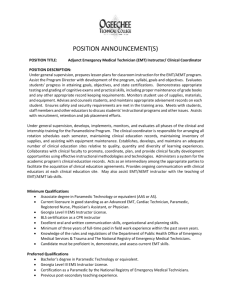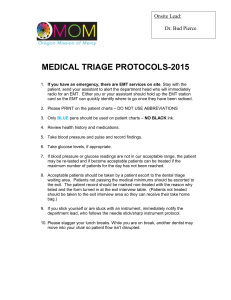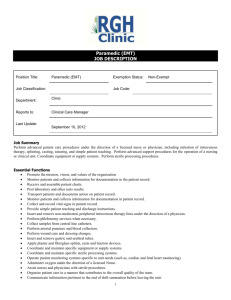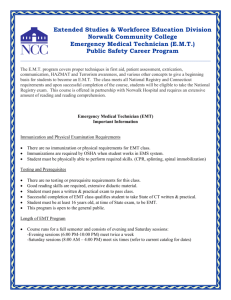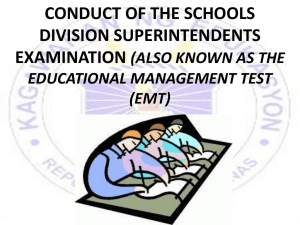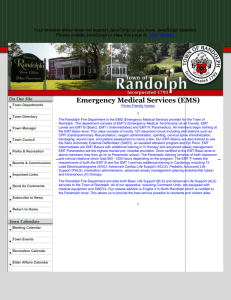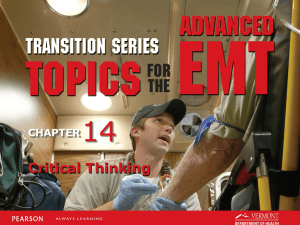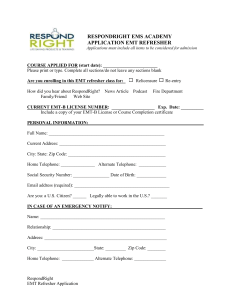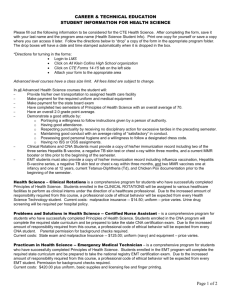Admission requirements All BCC Paramedic students must have the
advertisement
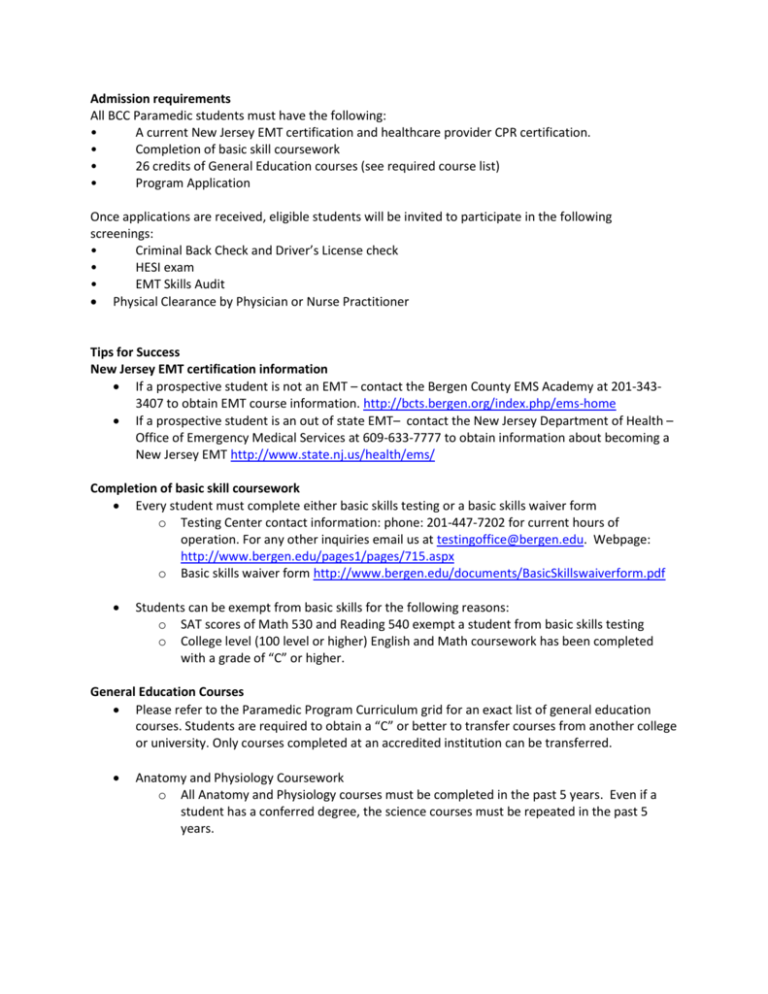
Admission requirements All BCC Paramedic students must have the following: • A current New Jersey EMT certification and healthcare provider CPR certification. • Completion of basic skill coursework • 26 credits of General Education courses (see required course list) • Program Application Once applications are received, eligible students will be invited to participate in the following screenings: • Criminal Back Check and Driver’s License check • HESI exam • EMT Skills Audit Physical Clearance by Physician or Nurse Practitioner Tips for Success New Jersey EMT certification information If a prospective student is not an EMT – contact the Bergen County EMS Academy at 201-3433407 to obtain EMT course information. http://bcts.bergen.org/index.php/ems-home If a prospective student is an out of state EMT– contact the New Jersey Department of Health – Office of Emergency Medical Services at 609-633-7777 to obtain information about becoming a New Jersey EMT http://www.state.nj.us/health/ems/ Completion of basic skill coursework Every student must complete either basic skills testing or a basic skills waiver form o Testing Center contact information: phone: 201-447-7202 for current hours of operation. For any other inquiries email us at testingoffice@bergen.edu. Webpage: http://www.bergen.edu/pages1/pages/715.aspx o Basic skills waiver form http://www.bergen.edu/documents/BasicSkillswaiverform.pdf Students can be exempt from basic skills for the following reasons: o SAT scores of Math 530 and Reading 540 exempt a student from basic skills testing o College level (100 level or higher) English and Math coursework has been completed with a grade of “C” or higher. General Education Courses Please refer to the Paramedic Program Curriculum grid for an exact list of general education courses. Students are required to obtain a “C” or better to transfer courses from another college or university. Only courses completed at an accredited institution can be transferred. Anatomy and Physiology Coursework o All Anatomy and Physiology courses must be completed in the past 5 years. Even if a student has a conferred degree, the science courses must be repeated in the past 5 years. Program Application Program applications will be available via the www.Bergen.edu site each year during the month of October until February 1. Applications are only accepted electronically. Applications submitted after the deadline will not be accepted. It is the sole responsibility of the student to maintain the email address submitted on the program application. Notifications to students will be done via email about required actions to be taken which will have an assigned timeframe to be completed. Only students who respond within the assigned timeframes will move forward in the process. Criminal Background Check (CBC) and Driver’s License Abstract Once initial applications are screened for eligibility, students will be notified of the process to complete a CBC and Driver’s License Abstract if eligible. This requirement cannot be replaced with another form of CBC. Applicants must complete the CBC following the directions outlined in the email notification. HESI exam • Once a student is cleared from the CBC process, they will be invited to complete the HESI examination. This exam assesses baseline knowledge in various areas related to Health Professions. The subjects required for admissions to the Bergen Community College Paramedic Science Program are; Math, Reading, Vocabulary, Grammar, Anatomy and Physiology. In addition, students will complete a Learning Styles and Personality Traits assessment. • To prepare for the HESI exam (basic skills exam for health professions) purchasing exam prep book ISBN-13: 9781455703333 Edition: 3 Pub. Date: March 2012 Publisher: Elsevier Health Sciences is probably the best approach. There are many free web-based resources such as http://quizlet.com/2079509/hesi-entrance-exam-flash-cards/ also available. EMT Skills Audit • After the HESI examination, eligible students will be invited to take an EMT skills audit. The audit will consist of two simulation scenarios where applicants will be assessed on their poise, EMT assessment skills, clinical judgment and ability to correctly manage the patient case as an EMT. The case may include an adult or pediatric patient suffering from a medical and/or trauma ailment. • The best way a student can prepare for the skills audit is to make the most of their EMT skills every time they have a patient interaction. This begins by reviewing information from a current EMT textbook. One reference suggested is BLS Skills Review ISBN: 978-0-7637-4684-1 published by Jones and Bartlett. In addition to preparing from a textbook, students are encouraged to make the most of their EMT patient interactions (emergent and non-emergent patient experiences). All of this information should be done with a focus of maintaining confidentiality and adhering to federal HIPAA (Health information Privacy) laws. On every EMT patient interaction, students should obtain the following information: o Understand why the patient called 9-1-1 or required a transport. o Evaluate the patient’s medical history. What medical history is associated with why the patient needed a transport? o o Identify clinical signs and symptoms. After the call, research the signs and symptoms with the medical history – were their signs and symptoms expected/typical or rare for the condition? What correlations can you make about their medical history, signs and symptoms and reason that they needed a transport? Identify prescribed medications. After the call, research these medications to better understand their effects and which medical history diagnosis they are associated. Become familiar with prescribed medications and the medical diagnoses that they are associated. Physical Clearance by Physician or Nurse Practitioner • Students are required to complete a physical screening and show proof of vaccine titer status, Mantoux skin test, Flu shot declaration and urine drug screen. The expense of this screening is the responsibility of the student.

